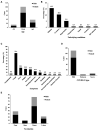The clinical characteristics and risk factors for severe COVID-19 in patients with COVID-19 and tuberculosis coinfection
- PMID: 36619998
- PMCID: PMC9817148
- DOI: 10.3389/fmicb.2022.1061879
The clinical characteristics and risk factors for severe COVID-19 in patients with COVID-19 and tuberculosis coinfection
Abstract
Background: Under the wave of the severe acute respiratory syndrome-coronavirus-2 (SARS-CoV-2) variant Omicron epidemic, the number of infectious cases has increased dramatically in Jilin Province, China since March 2022.The clinical features and severity of SARS-CoV-2 Omicron variant infection in tuberculosis (TB) patients are not yet clear.
Methods: Data were obtained from 153 patients with the Omicron variant and TB coinfection and 153 non-TB COVID-19 patients who had been hospitalized at Changchun Infectious Disease Hospital from March to June 2022.
Results: Among these coinfection patients, 17 patients showed COVID-19-related pneumonia on chest imaging and 11 were diagnosed with severe COVID-19. The median duration of SARS-CoV-2 clearance was 13 days. The negative conversion time was associated with age, COVID-19-related pneumonia and antibody IgG. A higher white blood cell count, a lower lymphocyte percentage, a higher CRP level, and a higher D-dimer level were found in the severe group. Age and increased PCT were individual risk factors for the severity of COVID-19. Compared with the non-TB patients, the coinfection patients had higher severity of COVID-19 and the elder coinfection patients had a longer negative conversion time.
Conclusion: This study found an association between age, pneumonia, antibody IgG and RNA negative conversion time in COVID-19 and TB coinfection patients, and age and increased PCT were risk factors for the severity of COVID-19.
Keywords: COVID-19; RNA negative conversion time; clinical characteristics; coinfection; epidemiological; tuberculosis.
Copyright © 2022 Wang, Chen, Gu, Lou, Zhang and Zhang.
Conflict of interest statement
The authors declare that the research was conducted in the absence of any commercial or financial relationships that could be construed as a potential conflict of interest.
Figures

Similar articles
-
Tuberculosis and COVID-19: Lessons from the Past Viral Outbreaks and Possible Future Outcomes.Can Respir J. 2020 Sep 5;2020:1401053. doi: 10.1155/2020/1401053. eCollection 2020. Can Respir J. 2020. PMID: 32934758 Free PMC article. Review.
-
Clinical manifestations of active tuberculosis patients coinfected with severe acute respiratory syndrome coronavirus-2.J Clin Tuberc Other Mycobact Dis. 2023 May;31:100359. doi: 10.1016/j.jctube.2023.100359. Epub 2023 Mar 5. J Clin Tuberc Other Mycobact Dis. 2023. PMID: 36945658 Free PMC article.
-
TB and COVID-19: An Exploration of the Characteristics and Resulting Complications of Co-infection.Front Biosci (Schol Ed). 2022 Mar 1;14(1):6. doi: 10.31083/j.fbs1401006. Front Biosci (Schol Ed). 2022. PMID: 35320917 Free PMC article. Review.
-
Clinical Characteristics and Outcome of Hospitalized COVID-19 Patients in a MERS-CoV Endemic Area.J Epidemiol Glob Health. 2020 Sep;10(3):214-221. doi: 10.2991/jegh.k.200806.002. J Epidemiol Glob Health. 2020. PMID: 32954712 Free PMC article.
-
COVID-19 and tuberculosis: A mathematical model based forecasting in Delhi, India.Indian J Tuberc. 2020 Apr;67(2):177-181. doi: 10.1016/j.ijtb.2020.05.006. Epub 2020 May 12. Indian J Tuberc. 2020. PMID: 32553309 Free PMC article.
Cited by
-
Comparative Insights into COVID-19 and Tuberculosis: Clinical Manifestations, Inflammatory Markers, and Outcomes in Pulmonary Versus Extrapulmonary Tuberculosis and SARS-CoV-2 Co-Infection.J Clin Med. 2025 Apr 17;14(8):2782. doi: 10.3390/jcm14082782. J Clin Med. 2025. PMID: 40283612 Free PMC article.
-
The Important Role of Preoperative D-Dimer in Constrictive Pericarditis.Ther Clin Risk Manag. 2024 May 6;20:239-247. doi: 10.2147/TCRM.S462075. eCollection 2024. Ther Clin Risk Manag. 2024. PMID: 38736988 Free PMC article.
-
Suppressive myeloid cells in SARS-CoV-2 and Mycobacterium tuberculosis co-infection.Front Immunol. 2023 Jul 20;14:1222911. doi: 10.3389/fimmu.2023.1222911. eCollection 2023. Front Immunol. 2023. PMID: 37545508 Free PMC article.
-
COVID-19 Vaccine Uptake: Prevalence, Health Facility Enablers and Barriers among Adult Tuberculosis Patients across Nairobi County Clinics, Kenya.J Tuberc Res. 2025;13(1):15-28. doi: 10.4236/jtr.2025.131002. J Tuberc Res. 2025. PMID: 40276674 Free PMC article.
-
Associations between genetic mutations in different SARS-CoV-2 strains and negative conversion time of viral RNA among imported cases in Hangzhou: A cross-sectional study.Virus Res. 2024 Jul;345:199400. doi: 10.1016/j.virusres.2024.199400. Epub 2024 May 20. Virus Res. 2024. PMID: 38763300 Free PMC article.
References
-
- Aleem A., Akbar Samad A. B., Slenker A. K. (2022) in Emerging variants of SARS-CoV-2 and novel therapeutics against coronavirus (COVID-19). ed. Island T. (FL: StatPearls Publishing; ) - PubMed
-
- Björk J., Bonander C., Moghaddassi M., Rasmussen M., Malmqvist U., Inghammar M., et al. . (2022). COVID-19 vaccine effectiveness against severe disease from SARS-CoV-2 omicron BA.1 and BA.2 subvariants - surveillance results from southern Sweden, December 2021 to March 2022. Euro Surveill. 27:2200322. doi: 10.2807/1560-7917.ES.2022.27.18.2200322 - DOI - PMC - PubMed
-
- CDC (2022). Guidelines for prevention and control of novel coronavirus (edition 9). Available at: http://www.nhc.gov.cn/jkj/s3577/202206/de224e7784fe4007b7189c1f1c9d5e85/... (Accessed June 27, 2022).
LinkOut - more resources
Full Text Sources
Research Materials
Miscellaneous

